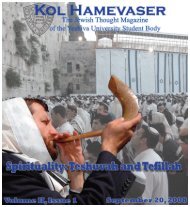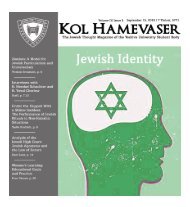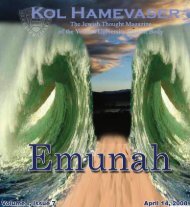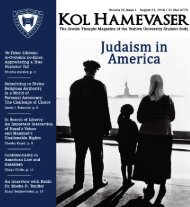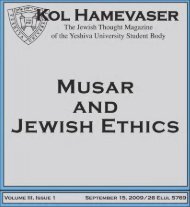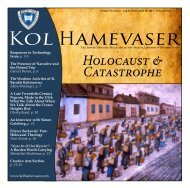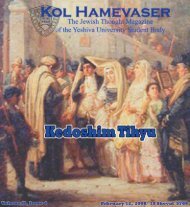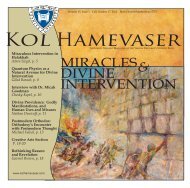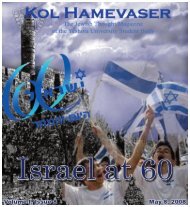Create successful ePaper yourself
Turn your PDF publications into a flip-book with our unique Google optimized e-Paper software.
xv One might argue that there are Jews in the<br />
world who are making siyyumim every month,<br />
who are learning in depth, with great care <strong>and</strong><br />
focus, <strong>and</strong> who are spiritually quite alive <strong>and</strong><br />
well. I am not denying this. But I would argue<br />
that such individuals are either unusually<br />
bright or are learning fulltime <strong>and</strong> can afford<br />
to attach deadlines to their talmud Torah without<br />
hurting the quality <strong>and</strong> spirituality of their<br />
learning. In other words, they can eat their kugl<br />
<strong>and</strong> have it too.<br />
xvi Concerning the keeping of a heshbon ha-nefesh,<br />
I think it makes sense for a Jewish man<br />
or woman to only register his or her tangible<br />
religious activities. One can keep stats on how<br />
many times one went to minyan that month or<br />
how many hours one spent in the Beit Midrash<br />
on a particular night, but to systematically<br />
record spirituality is a counterproductive <strong>and</strong><br />
absurd exercise for at least two reasons. First,<br />
this is true because one cannot rate things like<br />
love of God, fear of God, <strong>and</strong> love of one’s fellow<br />
Jew, <strong>and</strong> attempting to do so breeds frustration;<br />
second, one will not be able to<br />
concentrate on loving Jews or God or praying<br />
with sincerity if he is focused on the heshbon<br />
ha-nefesh he is going to have to write later that<br />
day!<br />
xvii Heschel, ibid.<br />
<strong>Halakhah</strong> <strong>and</strong> <strong>Minhag</strong><br />
BY: Jonathan Ziring<br />
Recently, <strong>Kol</strong> <strong>Hamevaser</strong> held its first<br />
school-wide Shabbaton. Over Shabbat,<br />
I was thinking about the importance<br />
of such an event, one where people who<br />
have a common interest in Jewish thought took<br />
the opportunity to spend time together, learn<br />
<strong>and</strong> just hang out. A few dictums of Hazal<br />
came to mind. The first is a fascinating state-<br />
ment in Bava Metsi’a: “Ula said, ‘Talmidei<br />
hakhamim in Bavel st<strong>and</strong> up for each other.’” i<br />
Rashi explains that they stood “the way a student<br />
does for his teacher, as they sat together<br />
constantly in the beit midrash, asking <strong>and</strong> answering<br />
each other’s questions, with everyone<br />
learning from each other.” ii Ramban exp<strong>and</strong>s<br />
on this idea, saying that not only did they st<strong>and</strong><br />
up when their friends came within four cubits<br />
of them, as would be required for any talmid<br />
hakham, but they even stood up as soon as they<br />
could see them at a distance, the way one is required<br />
to st<strong>and</strong> up before his primary teacher,<br />
his rav muvhak. iii He explains that although<br />
the talmidei hakhamim in Bavel did not actually<br />
learn the majority of their Torah from their<br />
colleagues, they still learned from each other<br />
constantly, <strong>and</strong> in certain respects they<br />
achieved the status of rav muvhak for each<br />
other. Now, while it is true that one Shabbat<br />
does not constitute “constantly,” over the<br />
course of those 25 hours I saw what promised<br />
to be the beginnings of a Torah community of<br />
people on both campuses (<strong>and</strong> beyond), who,<br />
by seriously discussing issues of Jewish<br />
thought <strong>and</strong> teaching each other, could grow<br />
together in their commitment as active members<br />
of broader Jewish society.<br />
One might ask, as many people do, why<br />
we need <strong>Kol</strong> <strong>Hamevaser</strong>; why have students<br />
present their ideas in a public format like this?<br />
After all, we learn in YU with Rashei Yeshivah<br />
who are tremendous talmidei hakhamim, <strong>and</strong><br />
while it is true that people can learn a lot from<br />
their peers, perhaps that is not an ideal? To me,<br />
this notion is absurd for several reasons. To<br />
begin with, when Rambam discusses the ideal<br />
friend that one should seek, he describes him<br />
as a “haver ma’alah,” an exalted friend. iv According<br />
to Rambam, he is the type of person<br />
who shares your goals <strong>and</strong> who wants to help<br />
you actualize your potential, just as you want<br />
to help him actualize his. He gives as an example<br />
of such a relationship the type of friendship<br />
found between teachers <strong>and</strong> their students.<br />
I have always understood from here that Rambam<br />
does not simply intend to describe the relationship<br />
that students have with their<br />
teachers, but rather means to encourage us to<br />
actively create friendships that parallel this<br />
<strong>Kol</strong> <strong>Hamevaser</strong>:<br />
Creating a Torah Community<br />
model, where we teach each other.<br />
Perhaps, though, my assumption about<br />
Rambam’s meaning is incorrect. For this, I<br />
turn to an interesting Mishnah in the fourth<br />
chapter of Avot: “R. Nehorai says, ‘Exile yourself<br />
to a place of Torah, <strong>and</strong> do not say it will<br />
come after you, for your friends will establish<br />
it in your h<strong>and</strong>s, <strong>and</strong> do not rely on your own<br />
underst<strong>and</strong>ing.’” v Most Rishonim underst<strong>and</strong><br />
that the word “friends” in this context is<br />
“Even the most brilliant Torah scholar needs colleagues.<br />
Friends sharpen each other, they help each other;<br />
that is the ideal.”<br />
generic, referring to one’s community, <strong>and</strong> that<br />
the Mishnah is warning people to remain in or<br />
seek out Torah communities. However, Sforno<br />
reads the Mishnah as an exhortation not to go<br />
to places where you would have no peers, even<br />
if you would be able to spread Torah among<br />
students there; rather, you should go to a community<br />
where you have equals, because it is<br />
only those who are on the same level of religious<br />
commitment <strong>and</strong> learning as you who<br />
will ensure that you keep your Torah, <strong>and</strong> no<br />
one else. vi He insightfully notes that the relationship<br />
you have with your friends is different<br />
than other relationships, <strong>and</strong> that to truly estab-<br />
lish yourself in the world of Torah, you need<br />
colleagues who can engage in that world with<br />
you – davka colleagues, not students, <strong>and</strong>, I<br />
would add, not teachers. Sforno continues by<br />
referencing the story in Shabbat 147b that<br />
gives the background to this statement of R.<br />
Nehorai. The Gemara identifies “R. Nehorai”<br />
as the nickname of R. Elazar ben Arakh, the<br />
sage who Abba Shaul claimed would outweigh<br />
all the scholars in the world combined as a result<br />
of his acuity. vii The Gemara recounts that<br />
R. Nehorai once forgot all of his Torah, despite<br />
his brilliance, to the point that he was unable<br />
to read a simple pasuk. To remedy this, his<br />
friends joined together <strong>and</strong> prayed for him, <strong>and</strong><br />
together helped him regain his scholarship.<br />
Even the most brilliant Torah scholar needs<br />
colleagues. Friends sharpen each other, they<br />
help each other; that is the ideal.<br />
However, there is a more fundamental<br />
reason why we must include everyone in the<br />
community of Torah. The Arukh ha-Shulhan,<br />
in his preface to Hoshen Mishpat, explains that<br />
the Torah is compared to a shirah, a song, viii because<br />
songs can be made more beautiful<br />
through the harmonization of different voices.<br />
So, too, he claims, the Torah is broadened,<br />
Volume III, Issue 7 www.kolhamevaser.com<br />
deepened, <strong>and</strong> made all the more stunning<br />
when different opinions are voiced in discussing<br />
it. Even if a Rosh Yeshivah may have<br />
great things to say, that does not negate the<br />
possibility that another voice might be able<br />
complement his. Shouldn’t we allow room for<br />
everyone to express his ideas (within reason),<br />
such that the Torah can become that much<br />
more complete? “I efshar le-beit ha-midrash<br />
be-lo hiddush:” ix everyone has a place in the<br />
beit midrash <strong>and</strong> every person has something<br />
to add to the discussion – <strong>and</strong> that includes all<br />
of our colleagues.<br />
On that note, I want to express my gratitude<br />
to all those who read, contribute to, <strong>and</strong><br />
edit <strong>Kol</strong> <strong>Hamevaser</strong> for helping cultivate a<br />
community of peers, one where we can all express<br />
our opinions freely <strong>and</strong> enrich the Torah<br />
by doing so. In the coming year, I look forward<br />
to the privilege of editing for the magazine<br />
myself <strong>and</strong> further taking part in this<br />
important endeavor. But, in truth, <strong>Kol</strong><br />
<strong>Hamevaser</strong> is just one way of creating this<br />
community. It should be our goal to create a<br />
Torah community that extends beyond the four<br />
amot of the battei midrash on both campuses,<br />
<strong>and</strong> that extends beyond the walls of our<br />
Yeshiva <strong>and</strong> our University, because, at the end<br />
of the day, we <strong>and</strong> our colleagues will be the<br />
“It should be our goal to create a Torah community that extends<br />
beyond the four amot of the battei midrash on both campuses, <strong>and</strong> that<br />
extends beyond that walls of our Yeshiva <strong>and</strong> our University, because,<br />
at the end of the day, we <strong>and</strong> our colleagues will be the ones to<br />
define Torah in 20 years, <strong>and</strong> we might as well start<br />
building the most complete community we can now.”<br />
ones to define Torah in 20 years, <strong>and</strong> we might<br />
as well start building the most complete community<br />
we can now. “Ve-Attah, kitvu lakhem<br />
et ha-shirah ha-zot” (And now, write for yourselves<br />
this song).<br />
Jonathan Ziring is a senior at YC majoring<br />
in Philosophy <strong>and</strong> Jewish Studies <strong>and</strong> is a<br />
Staff Writer for <strong>Kol</strong> <strong>Hamevaser</strong>.<br />
i Bava Metsi’a 33a.<br />
ii Rashi ad loc., s.v. “Omedin.”<br />
iii Ramban ad loc., s.v. “Ha.” See also Rashba,<br />
Ritva, <strong>and</strong> Ran ad loc., as well as Ramban in<br />
Torat ha-Adam, Sha’ar ha-Keri’ah.<br />
iv Rambam, Commentary to the Mishnah, Avot<br />
1:6, s.v. “Ve-Ameru u-keneh lekha haver.”<br />
v In most counts, Avot 4:14.<br />
vi Sforno ad loc.<br />
vii Avot 2:12.<br />
viii Devarim 31:19.<br />
ix See Hagigah 3a for context.<br />
7



